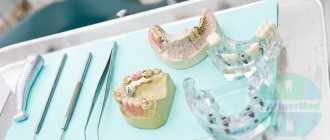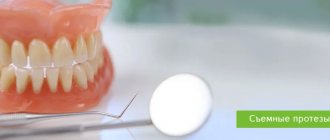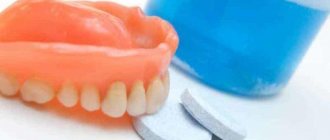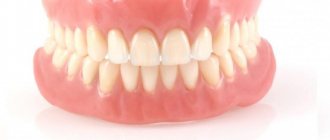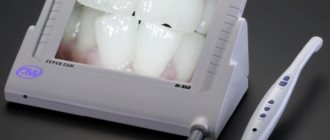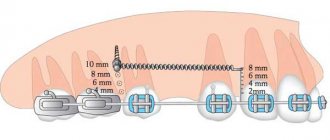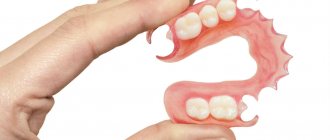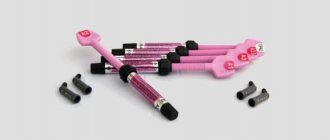Initially, removable soft dentures were used exclusively for temporary dental prosthetics. Patients wore them during the production of a rigid permanent structure in order to hide dental defects from others. Due to their softness, elasticity and ability to withstand heavy loads, dentures were highly appreciated by users and dentists, after which they underwent certain improvements.
Now in the USA, a non-deformable and non-breakable silicone or nylon prosthesis is recommended for constant wear by police officers and representatives of other professions who daily face the possibility of injury in the workplace.
Are you deciding which prosthesis to choose for partial or full dentures? Evaluate the advantages and disadvantages of a soft removable design. Perhaps in your case it will be the best option.
What is a nylon prosthesis
Removable nylon dentures are soft orthopedic structures made of a pink, gum-colored nylon base with invisible clasps that hold it in the mouth. The fixation is on the adjacent teeth; the hooks wrap around the supports, keeping the prosthesis stationary on the jaw. Artificial crowns are placed on an elastic frame.
A person can take off and put on a nylon prosthesis without assistance. They are used in dentistry as a temporary solution during implantation (during the process of osseointegration) or as a permanent prosthesis according to indications.
Nylon is a polymer that has the quality of flexibility, and under certain conditions, in the patient’s mouth, softness increases. As a denture material, it has come as an alternative to dental acrylic, to which some people are allergic.
Partial nylon prosthesis RUR 40,000. for all!
The price includes: diagnostics, impressions, manufacturing, installation, fitting and 1 year warranty! Complete denture Akrifri 1 jaw - 47,000 rub.!
How does a soft prosthesis work?
Structurally, it consists of three main elements:
- a translucent flexible base - an artificial analogue of the gum, matching it in color;
- invisible nylon hook-clasps, providing reliable fastening of the prosthesis to the gingival part of the supporting teeth;
- artificial teeth made of metal-ceramic or plastic and welded to a base.
Due to the softness of nylon, a removable denture does not injure the oral mucosa at all, and its fastenings do not damage tooth enamel. Thanks to staining with a hypoallergenic dye, the base of the prosthesis completely merges with the tissues of the oral cavity. The shade of artificial teeth is matched to the natural one, so the aesthetics of prosthetics are beyond praise: even a partial nylon structure adjacent to the patient’s natural teeth is absolutely invisible in the mouth.
Stages of manufacturing a flexible prosthesis
To create nylon dentures, you must first treat the teeth, perform removal according to indications, and then proceed to the following steps:
- taking impressions of jaws in a clinical setting;
- plaster models are made in the laboratory;
- a wax prototype of the prosthesis is cast, tried on, and finalized;
- a nylon final version is created, matched to the color of the gum. The equipment used is a heat press, in which polymer granules are melted and an individual mold is poured in a liquid state. After hardening, the structure is polished.
Clasps are a continuation of nylon dentures and are therefore completely invisible on the jaw even when smiling and talking.
How much do partial dentures cost?
The cost of partial dentures depends on several factors, the main ones being the number of teeth being restored and the material used.
| View | Price |
| Butterfly prosthesis | From 3,000 rubles |
| Plastic partial denture | From 7,000 rubles |
| Clasp prosthesis | From 25,000 rubles (with clasps) From 35,000 rubles (with attachments) From 80,000 rubles (with telescopic crowns) |
| Nylon prosthesis “Quadrotti” | From 37,000 rubles |
| Prosthesis "Acry Free" | From 35,000 rubles |
Indications for installation
Indications for removable nylon dentures can be:
- loss of one or more teeth in a row;
- scattered defect;
- absence of all teeth;
- allergy to metal, acrylic;
- if you do not want to grind the supporting teeth for dentures, for example, clasp ones with locks;
- periodontal disease of 1st and 2nd degrees to keep teeth in place (but 3.4 degrees will already be a contraindication);
- patient refusal or medical contraindications to implantation;
- childhood, if necessary, hide early tooth loss;
- as a temporary solution for implantation with delayed loading.
Sometimes nylon dentures can be installed to treat bruxism, involuntary grinding in the mouth, which damages tooth enamel and increases wear. And also for athletes and people involved in traumatic sports, a flexible design is the best option, better than acrylic, which can easily break in case of injury.
Contraindications
What may be a contraindication to a nylon prosthesis in dentistry:
- periodontal diseases (grade 3-4 periodontal disease), loose teeth, their displacement;
- recession;
- the height of the supporting teeth is not enough, the clasps will not be able to securely fasten;
- inflammatory processes of the mucous membrane and gums;
- tooth mobility;
- significant bone atrophy.
It is necessary to have healthy teeth on both sides of the prosthesis as supports for clasp fixation.
Comparison with acrylic dentures
The main competing technology is removable dentures made of acrylic plastic. However, they have a number of significant disadvantages:
- the presence of pores in which water stagnates and harmful microflora multiply;
- acrylic contains poisonous methyl ether, as well as a monomer that causes allergic reactions;
- the structures are unstable to chewing loads (80% of acrylic dentures break during use);
- metal clasps that secure the prosthesis are not only unaesthetic, but also capable of damaging and loosening the supporting teeth [1].
Clinical studies have shown that soft dentures receive more positive patient reviews compared to acrylic dentures. They adapt to them psychologically faster, and in the long term there are significantly fewer cases of traumatic damage to the gum mucosa. Thus, one year after the start of the experiment, mucosal injuries in the area of the supporting teeth were observed in more than 40% of patients with acrylic dentures and only in 20% of patients with nylon dentures [3]
However, the decision on the method of prosthetics should be made not after reading the article, but at an appointment with a specialist. The patient must listen to competent opinion and choose from the options that the dentist offers.
A nylon prosthesis is one of the methods of choice for prosthetics; it is not a panacea for all ills and not a solution to all problems.
The doctor decides which type of orthopedic device to choose for the patient, taking into account the medical history, clinical examination data, his experience and knowledge. Baranov A. B., orthopedic dentist, specialist in the field of removable prosthetics [2]
Varieties
There are:
- mini dentures for 1-2 teeth;
- partial (in the absence of three or more teeth);
- complete (replacing the dentition of the entire jaw).
Many people mistakenly believe that all flexible prostheses are nylon. This is wrong. They are very similar to the touch and in some characteristics. However, they should be considered separately.
Quadrotti prosthesis
A special modern type of prosthesis, which stands somewhere between clasp and nylon. It is more durable than the latter, has a little flexibility, and the fasteners are also not visible, unlike the clasp design, where, perhaps, this is the only drawback. The material of manufacture is monomer-free plastic.
Immediate prosthesis “butterfly”.
This is just a type of nylon prosthesis. It is used in cases where one, or less often, two teeth are missing. Small design, good replacement for a lost dental element. Produced quickly. The supporting teeth are not affected, that is, the doctor does not grind them down, they remain healthy and serve their term.
When is a removable partial denture placed?
Based on the name, you can understand that a partial removable dental prosthesis imitates a fragment of the dentition. This design can replace several missing teeth in a row or teeth lost in different areas of the jaw. Depending on this factor, the shape and size of the structure itself changes. In general, all types of removable dentures are united by a number of solutions. The base of a partial removable denture imitates soft tissues and part of the palate (if installed on the upper jaw). The boundaries of the prosthesis are clearly defined, since otherwise it would rest on the inner part of the base of the lips and would be unsuitable for wear. Artificial teeth made of plastic are installed in the base, which replace the crown part of missing natural teeth. In general, the design is quite simple, but this is precisely what makes this product so popular and widespread. There are a variety of materials used to make partial dentures, but some of them (for example, plastic) can cause allergic reactions.
Rules of care and wearing features
In order for the prosthesis to look aesthetically pleasing throughout the entire period of use, you should adhere to simple rules for caring for it:
- brush your teeth and teeth 2 times a day;
- the toothbrush should have soft bristles and the toothpaste should be non-abrasive;
- After each meal, also clean the product or rinse your mouth with water if it is not possible to remove and thoroughly wash the denture;
- take it to the dentist for professional cleaning twice a year;
- do not store in a dry place;
- periodically use a special solution to disinfect and clean removable dentures.
Fixation and stabilization of partial dentures
Methods for fixing partial removable dentures have remained unchanged over the past 10 to 20 years, i.e., since the advent of modern plate dentures.
| Fixation method | Description |
| Clasps | Metal or silicone hooks that fit around natural teeth and secure the denture in the mouth. |
| Attachmen | Micro-locks are installed on the supporting teeth, which snap into place upon contact with the structure. |
| Telescopic crowns | They are considered a very complex structure. The natural tooth is prepared and a special metal cap is put on it, after which a clasp prosthesis with grooves for fastening is installed. |
Advantages
An undoubted advantage is the aesthetic appearance, better than that of acrylic and clasp structures. And:
- light weight, which is a significant factor for the upper jaw, where a person feels every gram of a foreign body;
- small basis. There is no wide part blocking the sky, like the plate analogue, which is much more comfortable;
- quick addiction is due to the two points above;
- “invisible prosthesis”, invisible to others, a person can laugh and talk without hesitation. Nylon, in this sense, is a good material; it perfectly imitates gums. And since the clasps are a continuation of the base and are of the same color, they are attached directly to the gums behind the supporting tooth, so they are not visible. What is an advantage over metal visible hooks of clasp structures and acrylic ones;
- hypoallergenic. The production does not use toxic monomers that are added to the plastic mass of acrylic prostheses. They are the ones who cause allergies in patients. By the way, other alternatives to prosthetics have appeared for such sensitive people - Acry Free;
- there is no metallic taste in the mouth due to the absence of metal in the composition;
- The next plus will be felt by people who have a small mouth. Opening it wide to install a large prosthesis is not very comfortable. But not in this case. Nylon bends easily and does not require such sacrifices from patients.
Flaws
It cannot be said that all the disadvantages that we describe below apply to mini-prostheses. They are the ones who receive the least number of complaints. But larger designs definitely have the following negative nuances:
- uneven load when chewing and discomfort when chewing food. The base is flexible and when bitten it bends even more, all the pressure goes to one area, which causes pain. Since the load is not distributed over the entire prosthetic bed, the tissues underneath it atrophy;
- rapid atrophy. Under any removable denture this process occurs and the height of the alveolar ridge is lost. You can find figures about 1mm per year. Loss of tissue leads to subsidence of the prosthesis;
- damage to the gums in the area of clamp fixation. Unlike the clasp type and the plate type, where the hooks wrap around the neck of the supporting tooth, nylon dentures have a gingival attachment. Therefore, the load when chewing is transferred not to the tooth, but to the gum, which over time injures it;
- a fairly rapid decline in aesthetics. Nylon scratches, becomes sticky over time, and attracts dirt;
- beyond repair;
- short service life - up to 5 years and at the same time the need for frequent corrections.
Patient reviews
Olesya
We ordered nylon prostheses for my mother. At first everything was fine, but now she suffers from pain while eating. The doctor promised that everything would get better soon. We've been waiting for three months now, but the pain still remains.
Yuri
My brother has been wearing a soft prosthesis for 4 years. He is missing one tooth and cannot afford implants. The main thing is not to forget to clean it immediately. In general everything is good.
Hope
It took me a very long time to get used to this device in my mouth. But the food that keeps getting under it is still annoying. And cleaning takes a lot of time.
Lera
I'm still young, and I'm missing 3 teeth. The doctor recommended a soft partial denture. I was so afraid that he would be noticeable. But no, the color was matched perfectly to my gums. They have a chic aesthetic.
Vladimir
I've been wearing a nylon prosthesis for a year now. I don't like the fact that it absorbs all odors. Yes, and they cost me a lot. But on the outside, the teeth look like their own.
In any case, before installing any dental devices, it would be a good idea to read reviews from other patients who have already installed similar structures. After all, the modern beauty and health industry, thanks to powerful advertising, does not always live up to our expectations. Therefore, you should not make decisions frivolously that cost a tidy sum of money, but quickly lead to disappointment. I wish you health and the right choice in everything!
Sources used:
- “Partial removable dentures” (Zhulev E.N.)
- National Library of Medicine (USA)
- Chalifoux, Paul R. (2015). "Acrylic and other resins: Provisional restorations". Acrylic and other resins: Provisional restorations – Esthetic Dentistry (Third Edition)
Expert opinion
Roman Borisovich Alekperov
orthopedic dentist
Experience: 24 years
The choice of flexible prostheses is based mainly on the patient’s desire to receive maximum comfort from wearing an orthopedic structure. Nylon or silicone prostheses do not require long-term adaptation - made from an individual cast, they immediately sit comfortably and allow you to chew food and speak normally. It is important to remember that long-term wearing of flexible prostheses can lead to the development of atrophic processes in bone tissue, since these structures do not have a rigid base. Do not use flexible dentures for more than 6-9 months if you are planning to have implants. If such a situation occurs and the bone is “gone,” it will be necessary to pre-build it or perform basal implantation.
Examples of work “Before” and “After”
Partial restoration of teeth on both jaws
Case: partial absence of teeth on both jaws.
Complete prosthetics of the upper and lower jaws
Case: absence of teeth in the upper jaw (completely), absence of an orthopedic structure in the lower jaw on existing implants (installed in the USA two years earlier) Work: production of a complete removable denture in the upper jaw as a temporary structure until the installation of one-stage implants with subsequent prosthetics.
Installation of plate dentures with complete edentia (April 2012)
Case: complete absence of teeth in the upper and lower jaws, weak fixation of the removable denture in the lower jaw.
Complete absence of teeth in the upper jaw
Case: Completely edentulous upper jaw Work: Complete removable plate denture - acrylic Number of visits: 4 Time: 2 weeks Cost: 25,000 rub.
Indications for soft dentures
- complete edentia of one or two jaws;
- partial loss of teeth, absence of individual units in different parts of the row;
- the patient’s desire to undergo prosthetics without preparing the lateral supporting units;
- during the manufacture of permanent structures;
- in case of allergic reactions to other materials used to restore missing teeth;
- if the patient’s hobby or professional activity is associated with a high risk of injury.
Often, soft nylon prostheses are chosen by athletes whose activities are associated with the possibility of injury and the risks of installing permanent, ceramic or metal-ceramic structures. In addition, flexible products are indicated for advanced forms of periodontal disease, the absence of end elements of a row, or when it is impossible to use other types of dentures.
